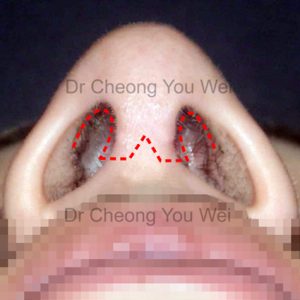Introduction to Rhinoplasty (Nose Job)
Introduction to Rhinoplasty (Nose Job)
The nose is located in the centre of the face and has great influence on facial aesthetics and attractiveness. An attractive nose has a fine tip, a straight nose bridge and a symmetric profile that blends elegantly into the face.
Rhinoplasty, also commonly known as nose job, refers to the various procedures to reshape and modify the nose’s shape and form. Rhinoplasty aims to reshape the nose so that the nose enhances the overall facial profile. Rhinoplasty may involve reshaping different parts of the nose, which include the nose tip (see Tip-plasty), nose bridge (see Nose Augmentation), nostrils and nasal alae (see Alarplasty), and columella of the nose. Rhinoplasty is one of the most common cosmetic surgeries performed worldwide.
Non-surgical nose reshaping procedures include filler injection and thread lifting of the nose (see Filler and Thread Lift). Non-surgical procedures are simple to perform, and the recovery is faster. Since non-surgical procedures are not able to safely modify the anatomic structures inside the nose, they can only produce simple modifications to the nose. Moreover, the results are usually short-lasting, so that repeated treatments are required. Non-surgical nose reshaping may not be able to provide long term safe and satisfactory results.
Surgical rhinoplasty, or simply known as rhinoplasty, is a nose reshaping procedure that involves surgery. There are two types of rhinoplasty: closed rhinoplasty and open rhinoplasty.
- Figure 1: Closed rhinoplasty
- Figure 2: Open rhinoplasty
In closed rhinoplasty, the surgeon makes the incisions inside one or both the nostrils to gain access to the nose (Figure 1). Closed rhinoplasty is suitable for cases that require minor to moderate correction and reshaping, such as augmentation of the nasal bridge using nose implant or minor refinement of the nasal tip. The advantages of closed rhinoplasty are shorter operating time, less swelling, and faster recovery time. Since the incisions are inside the nostrils, there will be no visible external scarring. However, because of the limited exposure and access, closed rhinoplasty may not be suitable for cases that require complex reshaping and profound changes to the nose .
Open rhinoplasty involves an extra incision to the columella in addition to the incisions inside the nostrils (Figure 2). This extra incision enables the surgeon to lift the skin and open up the nose. The main advantage of the open rhinoplasty over the closed rhinoplasty is that it offers a much better exposure and visualisation of the nose’s internal structures. This advantage enables the surgeon to modify and alter various nasal structures with greater control and precision. Open rhinoplasty is a versatile approach that can address a wide range of conditions effectively, such as correction of a bulbous nose, short nose, upturned nose, deviated nose, refinement the nose tip (Tip-plasty) and secondary rhinoplasty. Cartilage grafts harvested from the ear, rib or nasal septum are often used in open rhinoplasty to reconstruct the nasal framework.The extra incision on the columella usually heals very well and the scar is inconspicuous after fully recovered.
The selection of which procedure to use in nose reshaping depends on various factors. These include the changes that the patient desires, the existing anatomy of the nose, the existing abnormalities of the nose, history of previous nose surgery, and patient preference. Each case of rhinoplasty is unique and requires careful assessment and planning. Proper discussion between the patient and the surgeon is essential to ensure a good understanding regarding treatment options and the anticipated outcome.










